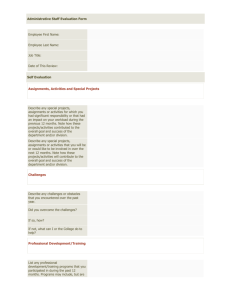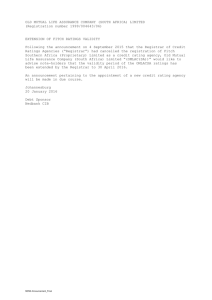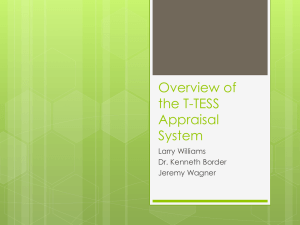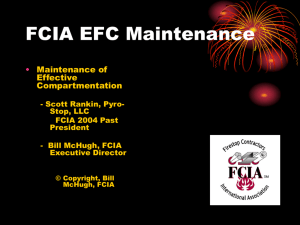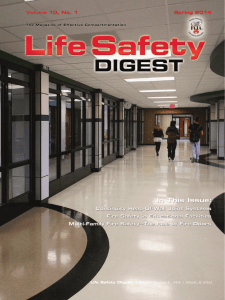UL's New “W” and “L” Ratings
advertisement
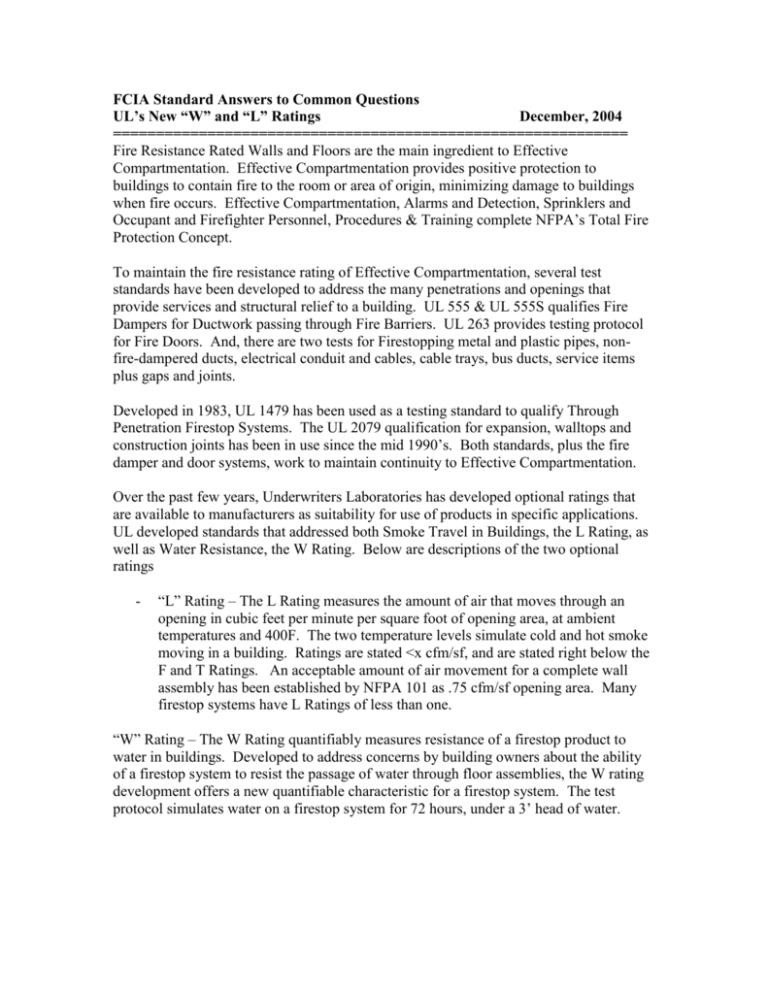
FCIA Standard Answers to Common Questions UL’s New “W” and “L” Ratings December, 2004 ============================================================ Fire Resistance Rated Walls and Floors are the main ingredient to Effective Compartmentation. Effective Compartmentation provides positive protection to buildings to contain fire to the room or area of origin, minimizing damage to buildings when fire occurs. Effective Compartmentation, Alarms and Detection, Sprinklers and Occupant and Firefighter Personnel, Procedures & Training complete NFPA’s Total Fire Protection Concept. To maintain the fire resistance rating of Effective Compartmentation, several test standards have been developed to address the many penetrations and openings that provide services and structural relief to a building. UL 555 & UL 555S qualifies Fire Dampers for Ductwork passing through Fire Barriers. UL 263 provides testing protocol for Fire Doors. And, there are two tests for Firestopping metal and plastic pipes, nonfire-dampered ducts, electrical conduit and cables, cable trays, bus ducts, service items plus gaps and joints. Developed in 1983, UL 1479 has been used as a testing standard to qualify Through Penetration Firestop Systems. The UL 2079 qualification for expansion, walltops and construction joints has been in use since the mid 1990’s. Both standards, plus the fire damper and door systems, work to maintain continuity to Effective Compartmentation. Over the past few years, Underwriters Laboratories has developed optional ratings that are available to manufacturers as suitability for use of products in specific applications. UL developed standards that addressed both Smoke Travel in Buildings, the L Rating, as well as Water Resistance, the W Rating. Below are descriptions of the two optional ratings - “L” Rating – The L Rating measures the amount of air that moves through an opening in cubic feet per minute per square foot of opening area, at ambient temperatures and 400F. The two temperature levels simulate cold and hot smoke moving in a building. Ratings are stated <x cfm/sf, and are stated right below the F and T Ratings. An acceptable amount of air movement for a complete wall assembly has been established by NFPA 101 as .75 cfm/sf opening area. Many firestop systems have L Ratings of less than one. “W” Rating – The W Rating quantifiably measures resistance of a firestop product to water in buildings. Developed to address concerns by building owners about the ability of a firestop system to resist the passage of water through floor assemblies, the W rating development offers a new quantifiable characteristic for a firestop system. The test protocol simulates water on a firestop system for 72 hours, under a 3’ head of water. FCIA Standard Answers to Common Questions UL’s New “W” and “L” Ratings December, 2004 ============================================================ The 3’ head of water does not translate into 3’ of water ponding on the entire floor assembly, as the floor might collapse. It simply simulates water on top of the material, to provide pressure that may cause water to transfer to the bottom side of the assembly. There are some key points about the W and L Ratings for Specifiers and Contractors to know. - Specification Requirements – Specifications have been appearing for both L and W Ratings on projects nationwide. o L Ratings - When specifying firestopping in fire and smoke resistance rated construction, specify L Rated Systems. The L Rating is the qualification for fire resistance rated smoke protection. o W Ratings – When specifying firestopping in floor systems, specify a W Rating for areas that may need water resistance. Specifying a W Rating provides protection against water from floor to floor. - Responsibility Requirements – Once specified, who is responsible for protection in buildings? Currently, the warranty offerred by most firestopping manufacturers is a material warranty for one year (1) from date of shipment. There is no warranty from the manufacturers for labor and material together. Contractors may provide. FCIA therefore recommends specifiers and owners consider the Firestopping Quality Process, FCIA Member Specialty Firestop Contractors, FM 4991 Approved, Inspected to ASTM E 2174/2393 Protocol. - Code Requirements – There are new code requirements that have recently passed for L Ratings, and none for W Ratings. o L Ratings – NFPA’s Technical Committee on Fire Protection Features recently voted positively for have new code language that quantifies a value for leakage through smoke resistance rated assemblies based on logic from the fire door and fire damper industry. Smoke Protection using firestopping in effective compartmentation is attainable with L Ratings. o W Ratings – There are no code requirements at this time for W Ratings in the International Building Code, NFPA 5000 or NFPA 101. Building owners and managers, architects and engineers have been requesting water resistance for many years. FCIA Standard Answers to Common Questions UL’s New “W” and “L” Ratings December, 2004 ============================================================ Effective Compartmentation was originally developed for protection from fire travel first from building to building, then from area to area in construction. When properly specified with tested and listed systems with F, T, L and W Ratings, installed by an FCIA Member, FM 4991 Approved Contractor, Inspected to ASTM E 2174 Inspection Standard, and properly maintained, Effective Compartmentation performs admirably. Contact FCIA for more information about Effective Compartmentation and Firestopping. Firestop Contractors International Association 1257 Golf Circle ~ Wheaton, IL 60187 630.690.0682 ~ 630.690.2871 FAX http://www.fcia.org ~ Email: info@fcia.org

